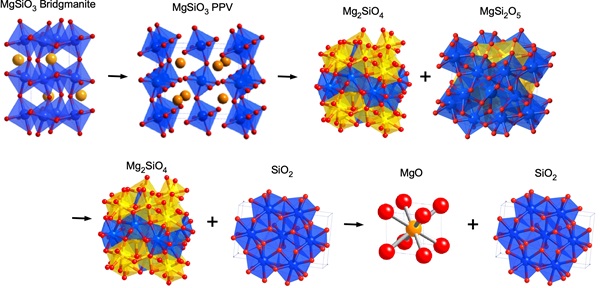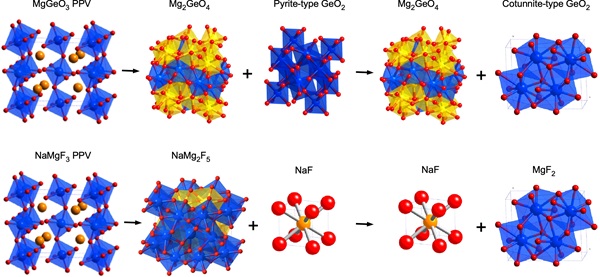The Ab initio study proposes two systems as low-pressure analogues for the post-post-perovskite transitions in the Mg-Si-O system, which are fundamentally important for understanding the deep interiors of super-Earths but are challenging to study experimentally. Mg-Ge-O and Na-Mg-F systems are very useful for experimental investigation of the post-post-perovskite phases, Mg2SiO4 and MgSi2O5, respectively.

Background
Bridgmanite, MgSiO3 perovskite, is the most abundant mineral in the lower mantle of the Earth. It transforms into the post-perovskite (PPV) structure close to core-mantle boundary conditions (~125 GPa). Although the PPV structure is the final form of MgSiO3 in the Earth, a natural question arises: what is next? What is the post-PPV transition? This question has gained importance, since many potential ‘super-Earths’ – terrestrial exoplanets whose masses are up to ~13 Earth masses (or less than one Uranus/Neptune mass) – have been discovered recently. Pressures in their mantles can reach up to ~2.5 TPa; such ultra-high pressures are expected to induce post-PPV transitions in the Mg-Si-O system. A series of predictions of post-PPV phase transitions in MgSiO3 and other stoichiometries in the Mg-Si-O system have been made and confirmed by several calculations. MgSiO3 should undergo the following three-stage dissociation: MgSiO3 PPV → Mg2SiO4 + MgSi2O5 → Mg2SiO4 + SiO2 → MgO + SiO2. When MgSiO3 coexists with MgO or SiO2, they should recombine into Mg2SiO4 or MgSi2O5, respectively. Predictions of these recombinations are unexpected. Mg2SiO4 polymorphs dominate the Earth’s upper mantle. The spinel form of Mg2SiO4 (ringwoodite) breaks down into MgSiO3 perovskite and MgO, defining the upper boundary of the Earth’s lower mantle. These predictions have been utilised in numerical modelling of the interiors of super-Earths. However, despite the importance of the post-PPV transitions in super-Earths, these predictions have not been confirmed experimentally. This is because the predicted transition pressures are extremely high, over ~500 GPa. Such high pressures are still difficult to achieve with diamond-anvil-cell experiments. Without experimental confirmation, the computational predictions might be seen as just a pie in the sky. For this reason, studies of ‘low-pressure-analogues’ (LPAs) of key high-pressure phases are important. Such analogue materials are expected to display similar phase relations and structure-property relations to the experimentally inaccessible high-pressure forms. Today, in this age of exoplanetary discoveries, the search for LPAs is more active than ever.

Research outcome
This research presents an ab initio investigation of the pressure-induced behavior of MgGeO3- and NaMgF3-perovskite, traditional LPAs of MgSiO3 bridgmanite. It is found that, although neither MgGeO3 nor NaMgF3 are perfect LPAs of MgSiO3, they are useful for several reasons: (1) both display the PPV transition observed in MgSiO3; (2) starting at ~20 GPa the Na-Mg-F system produces a novel NaMg2F5 phase by dissociation of NaMgF3 or by its compression with MgF2. Instead of following this pattern, the Mg-Ge-O system produces a Mg2GeO4 by dissociation of MgGeO3 or by its compression with MgO starting at ~200 GPa. Such pressures are routinely accessible in laser-heated diamond-anvil cells today; (3) like MgSiO3, both systems ultimately dissociate into the binary AX and BX2 compounds, confirming this trend in ternary systems first predicted in MgSiO3. It should be noted here that very recently the predicted post-PPV transitions in NaMgF3 were reported experimentally (Dutta et al., Proc. Nat. Acad. Sci. 116, 19324 (2019)). Based on the LPAs this research proposed, experimental studies on the post-PPV transitions will be facilitated, leading to further understanding of the deep interiors of super-Earths.
| Journal | Physical Review Materials |
| Tile of the paper | Ab initio exploration of post-PPV transitions in low-pressure analogs of MgSiO3 |
| Authors | Koichiro Umemoto1 and Renata M. Wentzcovitch2,3 |
| Affiliations |
1Earth-Life Science Institute, Tokyo Institute of Technology, Tokyo 152-8550, Japan. 2Department of Applied Physics and Applied Mathematics, Columbia University, New York, NY 10027, USA. 3Department of Earth and Environmental Sciences, Lamont Doherty Earth Observatory, Columbia University, New York, NY 10964, USA. |
| DOI | 10.1103/PhysRevMaterials.3.123601 |
| Online published date | Dec. 3, 2019 |
